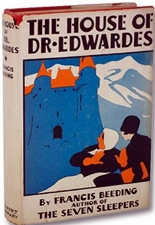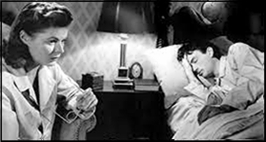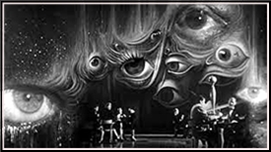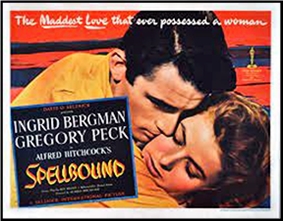Mon 24 Apr 2023
A Book! Movie!! Review by Dan Stumpf: FRANCES BEEDING – The House of Dr. Edwardes // SPELLBOUND (1945).
Posted by Steve under Films: Drama/Romance , Reviews[3] Comments

FRANCES BEEDING – The House of Dr. Edwardes. Little Brown, 1926. Filmed as Spellbound (Selznick/UA, 1945) with Ingrid Bergman, Gregory Peck, Michael Chekhov, Leo G. Carroll, Rhonda Fleming, John Emery, Norman Lloyd, Bill Goodwin, Wallace Ford, Art Baker, and Regis Toomey. Dream sequence based on designs by Salvador Dali. Screenplay by Ben Hecht and Angus MacPhail. Directed by Alfred Hitchcock.
A pleasant read, a fun movie, and an interesting glimpse into the creative process…..
The House of Dr. Edwardes is an out-and-out Gothic, set in a remote Castle/Sanitarium staffed by a few professionals and the kind of superstitious villagers who used to populate old horror movies. Into this moody-broody set-piece steps Constance Sedgewick, pretty young thing just out of Medical School and newly hired by Dr. Edwardes, who is conveniently away. Also recently arrived is Dr. Murchison, handsome and slightly sinister in the best Gaslight tradition, who arrived with a mysterious patient in tow, a homicidal maniac who is kept locked away.
It doesn’t take long to figure out the “surprise†here, but Beeding goes capably through the Gothic motions, with hints of Devil Worship, strange figures skulking about in the moonlight, and Constance following the standard policy of sneaking around the Castle in her nightdress. There’s also a very nice bit (probably what suggested the thing to Hitch in the first place) where an ordinary after-dinner conversation turns eerily menacing… the sort of catchy writing that makes one wish Beeding had provided a more imaginative resolution.

Looking at the film Spellbound, one is struck first by the tricky visuals -– including the dream sequence by Salvador Dali – and how well they serve the story. One might also note how completely screenwriters Ben Hecht and Angus MacPhail opened out the claustrophobic book with a bit of symbolic progression: as the characters move closer to solving the mystery and overcoming psychosis, the narrative moves from the cramped confines of the mental hospital to the looser framework of a big city, then to the broader vistas of a small town, and finally to the open slopes of a ski lodge (evoked with laughably bad back-projection!)

But I got the most fun reading Dr. Edwardes and reconstructing the thought processes of the writers as they tried to hammer it into a commercially viable Spellbound: “Okay we’ve got Ingrid Bergman, but no one’s gonna believe she’s just out of Med School; how ‘bout making her a cool-on-the-surface babe who takes off her glasses and her hair falls down around her shoulders? And what about Greg Peck? (WARNING!) Greg can’t be the killer but he can’t spend the whole damn film locked up in a cell, either. Hey, how about if we give it the twist-on-the-twist? He’s crazy, yeah, but the real Doc…
However it worked out, Edwardes was worked into an undisputed classic movie and required viewing for readers here.

April 25th, 2023 at 6:48 pm
Aside from his popular and well written Buchanesque spy novels Beeding also wrote this THE NORWICH VICTIM and DEATH AT EASTREPPS, a classic mystery suspense novel about the hunt for a serial killer, probably his most reprinted and familiar novel other than EDWARDES.
Beeding was two writers, John Edward Palmer and Hilary St.George Saunders who met while working for the League of Nations (series character Col Alister Granby was an agent of the League of Nations) and found between the two of them they had a knack for plot and attractive characterization.
Other titles include THE FIVE FLAMBOYS, THE HIDDEN HAND, THE SIX WALKERS, MURDERED ONE BY ONE, and MURDER INTENDED.
EASTREPPS is often listed as one of the best such books of its era.
As Dan says the book had some obvious attractions for Hitchcock, but also some big problems converting to the screen. Enjoyable as the film it it is not Hitch’s best, a bit over the top and perhaps to gimmicky with the Salvador Dali sequences.
One gimmick too often left out of television prints is the final color scene when the screen goes red.
April 25th, 2023 at 7:02 pm
The complete movie is here below (at least for now). The opening overture lasts just over four minutes:
Except for quite a few of Hitchcock’s early British movies, this may be the only one of his later films I’ve never seen.
April 25th, 2023 at 8:38 pm
Hitchcock’s first feature film was 1925 and his last 1976—so the mid point of his career was 1950 from a strictly timeline standpoint. On the other hand, he made 53 feature films and Spellbound was #31.
Looking at his oeuvre, it seems like Spellbound was the beginning of a 19 year period of incredible creativity for which Hitchcock is best remembered today:
Spellbound (1945)
Notorious (1946)
The Paradine Case (1947)
Rope (1948)
Under Capricorn (1949)
Stage Fright (1950)
Strangers on a Train (1951)
I Confess (1953)
Dial M for Murder (1954)
Rear Window (1954)
To Catch a Thief (1955)
The Trouble with Harry (1955)
The Man Who Knew Too Much (1956)
The Wrong Man (1956)
Vertigo (1958)
North by Northwest (1959)
Psycho (1960)
The Birds (1963)
Marnie (1964)